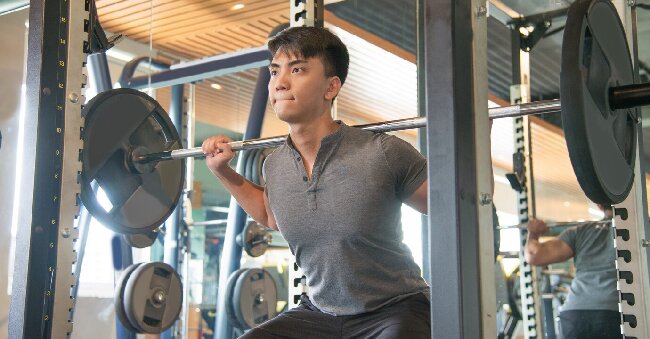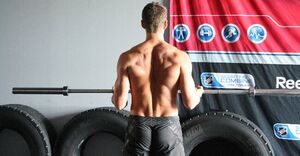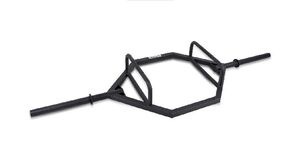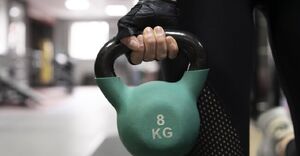
Smith Machine Squat Variations for Every Fitness Level
Have you ever wondered what the Smith Machine Squat is and how it can benefit your workout routine?
We will explore the different variations of Smith Machine Squats that cater to every fitness level, from beginners to advanced. Whether you are looking to target multiple muscle groups, improve stability, or simply switch up your routine, we have got you covered.
So, grab your gym gear and get ready to elevate your squat game with the Smith Machine!
What is the Smith Machine Squat?
The Smith Machine Squat is a compound exercise that targets a variety of leg muscles and is performed using a Smith machine, a popular piece of gym equipment.
This exercise is particularly effective in engaging muscles like the quadriceps, hamstrings, and glutes. By utilizing the Smith machine, which consists of a barbell fixed within steel rails, individuals can perform squats with added stability and support.
Incorporating Smith Machine Squats into your workout routine can help in improving lower body strength, stability, and overall muscle development. It is crucial to maintain proper form during this exercise, ensuring that your knees do not extend beyond your toes while keeping your back straight and core engaged.
How to Perform a Smith Machine Squat?
Executing a Smith Machine Squat correctly involves maintaining proper form and technique to ensure safety while focusing on factors like stance, range of motion, and core engagement.
- To initiate the squat, approach the Smith Machine with your feet shoulder-width apart and the barbell resting comfortably on your shoulders. Keep your chest up, shoulders back, and gaze forward to maintain a neutral spine throughout the movement.
- As you lower your body down, aim to descend until your thighs are parallel to the ground, ensuring your knees track in line with your toes. Engage your core muscles by bracing your abdomen and lower back to stabilize your body.
- Remember to breathe consistently throughout the exercise to support your exertions.
What are the Benefits of Smith Machine Squats?
Smith Machine Squats offer numerous benefits, including targeting multiple muscle groups, enhancing balance and stability, promoting muscle growth, and aiding in toning efforts.
Engaging in Smith Machine Squats not only activates major muscle groups like quadriceps, hamstrings, glutes, and calves but also recruits stabilizing muscles in the core and lower back. By challenging these muscle groups in a controlled manner, individuals can improve their overall strength and coordination. The added stability provided by the Smith Machine allows for better form and alignment, reducing the risk of injury and ensuring effective muscle engagement. Over time, consistent incorporation of Smith Machine Squats into a workout routine can lead to noticeable improvements in muscle tone and definition, contributing to a well-rounded fitness regimen.
Targets Multiple Muscle Groups
The Smith Machine Squat effectively engages key lower body muscles, including the quadriceps, hamstrings, and glutes, providing comprehensive muscle activation and stimulation.
This compound exercise targets multiple muscle groups simultaneously, making it a highly efficient workout choice for individuals looking to strengthen their lower body. By utilizing the Smith Machine for squats, you can ensure proper form and stability, allowing you to focus on maximizing muscle engagement. The quadriceps are primarily activated during the descent phase, while the hamstrings and glutes come into play when driving back up to the starting position, creating a well-rounded workout for overall muscle development in the legs.
Provides Stability and Safety
The Smith Machine Squat offers enhanced stability and safety compared to free weight exercises, with the machine’s controlled motion and potential for spotter assistance increasing safety measures during the workout.
This added stability is crucial for individuals who may struggle with maintaining balance or proper form when performing squats with traditional free weights. The guided vertical movement of the Smith Machine ensures that the body moves in a controlled path, reducing the risk of injury.
Spotters play a vital role in further enhancing safety by providing assistance if the person using the machine reaches muscle fatigue or encounters any difficulty during the exercise.
By collaborating with a spotter, individuals can push themselves safely, knowing that external support is available if needed.
Can Be Used for Different Fitness Levels
One significant advantage of the Smith Machine Squat is its versatility in catering to various fitness levels, from beginners to advanced individuals, offering progression options, modifications, and challenges for all.
Beginners can benefit from the stability provided by the Smith Machine’s guided motion, which helps in maintaining proper form and reducing the risk of injury. As they progress, adjustments can be made to increase resistance gradually.
For seasoned athletes, advanced variations like pause squats, tempo squats, or single-leg squats on the Smith Machine can enhance strength and stability further. The Smith Machine Squat can be adapted by changing foot placement, depth of squat, or adding resistance bands for those looking for specific muscle targeting or rehabilitation purposes.
What are the Different Variations of Smith Machine Squats?
- Smith Machine Squats offer a range of variations such as the Front Squat, Split Squat, Bulgarian Split Squat, Single Leg Squat, Sumo Squat, Box Squat, and Jump Squat, each targeting muscles in unique ways.
The Front Squat variation places more emphasis on the quadriceps and core stability compared to traditional back squats.
Split Squats engage the quadriceps, glutes, and hamstrings while improving single-leg stability.
Bulgarian Split Squats target the quads and glutes intensely with the front foot elevated.
Single Leg Squats challenge balance, stability, and muscle control, enhancing unilateral strength.
Sumo Squats focus on the inner thighs and glutes due to the wider stance.
Box Squats help improve squat depth and activate the posterior chain.
Jump Squats are explosive, targeting fast-twitch muscle fibers for power and vertical leap improvement.
Traditional Smith Machine Squat
The traditional Smith Machine Squat serves as a foundational leg exercise often incorporated into leg day routines, providing significant resistance to challenge the lower body muscles.
This exercise involves positioning oneself under the bar on a guided track, allowing for a controlled up-and-down movement while bearing the weight. The Smith Machine Squat is effective in targeting the quadriceps, hamstrings, glutes, and even the calves, making it a comprehensive lower body workout option. By adjusting the weight on the machine, individuals can tailor the resistance levels to their fitness level, progressing as they build strength and endurance. Incorporating this squat variation into a leg day routine helps improve overall lower body strength and stability, contributing to better performance in various activities.
Front Squat
The Front Squat variation of the Smith Machine Squat emphasizes core engagement and balance, shifting the focus to the front of the body and enhancing stability during the exercise.
Incorporating the Smith Machine for Front Squats challenges the core muscles to a greater extent due to the position of the weight in front of the body. This variation requires additional coordination and control to maintain proper form throughout the movement. Unlike the traditional back squat where the weight rests on the upper back, the front squat places more emphasis on the quadriceps and requires a more upright torso position, leading to increased activation of the core muscles for stability and balance.
Split Squat
The Split Squat variation in Smith Machine Squats targets the lower body with a focus on balance and depth, challenging the muscles in a unilateral movement pattern.
This particular form of the split squat, performed on the Smith Machine, adds an extra dimension to the exercise. By utilizing the Smith Machine for stability, individuals can achieve greater depth in their squat, allowing for increased engagement of muscles like the quads, hamstrings, and glutes.
This unilateral movement not only improves strength imbalances between the legs but also enhances core stability and proprioception. The controlled movement required in this variation helps in developing better overall lower body strength and can be a valuable addition to any leg day workout routine.
Bulgarian Split Squat
The Bulgarian Split Squat variation using the Smith Machine focuses on engaging the hamstrings and glutes, offering a challenging unilateral exercise to strengthen and tone the lower body muscles.
This type of squat variation is particularly beneficial for targeting each leg individually, helping to address muscle imbalances and improve stability. By isolating one leg at a time, the Smith Machine Squats in Bulgarian Split Squat form also enhance core strength and balance. Incorporating this exercise into your routine can lead to greater overall lower body strength and endurance, making daily activities easier and more efficient.
Single Leg Squat
The Single Leg Squat variation on the Smith Machine challenges stability and balance by focusing on unilateral leg strength, enhancing coordination and muscle activation.
This variation requires the individual to perform squats on one leg, which not only targets the quadriceps, hamstrings, and glutes but also engages the core for stabilization. The Smith Machine provides a guided vertical path, aiding in proper alignment during the exercise, further emphasizing the need for stability.
By isolating each leg separately, imbalances can be identified and corrected, leading to improved overall performance and reduced risk of injury. Incorporating Single Leg Squats into your routine can enhance functional strength and agility, making daily activities easier to perform.
Sumo Squat
The Sumo Squat variation performed on the Smith Machine targets the inner thighs and requires a wider stance, focusing on depth and the engagement of different lower body muscles.
By adopting a wide stance in the Sumo Squat variation within Smith Machine Squats, individuals can effectively isolate and strengthen their inner thigh muscles. The placement of the feet beyond shoulder-width apart helps activate the adductors and glutes to a greater extent compared to traditional squat variations.
Emphasizing proper depth is crucial in this exercise to fully engage the targeted muscles. Keeping the chest lifted and pushing the knees outwards while descending into the squat position enhances the muscle activation in the inner thighs, creating a challenging yet rewarding workout experience.
Box Squat
The Box Squat variation using the Smith Machine focuses on controlling depth and enhancing squatting technique by using a box or bench to dictate range of motion.
This particular variation is beneficial for individuals looking to refine their squatting form, as the box serves as a tangible marker for achieving consistent depth with each repetition. By sitting back onto the box before standing up, the lifter can ensure that they are hitting the desired squat depth every time, promoting muscle engagement and reducing the risk of injury from improper form.
The Smith Machine adds an extra layer of stability, making it ideal for beginners or those working on perfecting their squat technique.
Jump Squat
The Jump Squat variation on the Smith Machine adds an element of explosiveness and power training to the exercise, combining squatting motion with a dynamic jump movement.
This explosive movement engages fast-twitch muscle fibers, crucial for powerful movements, making it an excellent choice for athletes aiming to improve their agility and vertical jump.
The mechanics of the Jump Squat on the Smith Machine involve explosively driving through the heels, extending the hips, knees, and ankles during the jump phase. By focusing on the triple extension, this exercise enhances coordination and neuromuscular control, leading to improved overall athletic performance.
Incorporating Jump Squats into a lower body workout routine can significantly enhance lower body strength, explosiveness, and speed, making it a valuable addition for those seeking to boost their athletic capabilities.
How to Modify Smith Machine Squats for Different Fitness Levels?
Modifying Smith Machine Squats allows individuals of varying fitness levels, including beginners, intermediates, and advanced athletes, to customize their workout experience and progress over time.
For beginners looking to ease into Smith Machine Squats, it’s beneficial to start with just the bar to focus on form and build strength gradually. As you advance, consider adding weight in small increments to gradually increase resistance.
Intermediate individuals may incorporate pauses at the bottom of the squat to enhance muscle engagement and control. For advanced athletes seeking a challenge, incorporating single-leg Smith Machine Squats or plyometric variations can provide a new level of intensity and complexity to their training regimen.
By tailoring these modifications to individual needs and goals, individuals can optimize their Smith Machine Squat workouts for maximum effectiveness.
Beginners
For beginners, starting with the Smith Machine Squat involves focusing on proper technique, safety measures, and implementing modifications to gradually build strength and familiarity with the exercise.
- It is crucial to begin by setting the Smith Machine bar at an appropriate height, usually around shoulder level, to allow for comfortable movement.
- Placing your feet shoulder-width apart and engaging your core will help maintain stability throughout the squat.
- Remember to keep your chest up and back straight as you lower into the squat position.
Beginners should start with lighter weights to perfect their form before gradually increasing the resistance. Consider seeking guidance from a fitness professional to ensure proper execution and to prevent any risk of injury.
Intermediate
Intermediate users of the Smith Machine Squat can focus on refining form, correcting technique, and incorporating progression strategies to challenge muscle activation and development at a higher level.
One important aspect of form correction in the Smith Machine Squat is to ensure proper foot placement to maintain balance and engage the correct muscles effectively. Individuals can experiment with varying depths of the squat to target different muscle groups and improve overall strength. Progression techniques can involve increasing resistance gradually, such as adding weight or adjusting the rep range to continue challenging the muscles. Utilizing muscle activation strategies like engaging the core and focusing on mind-muscle connection can further enhance the effectiveness of each squat repetition.”
Advanced
Advanced practitioners can intensify their Smith Machine Squat routine by introducing challenges, focusing on muscle growth, enhancing coordination, and exploring advanced variations for a comprehensive lower body workout.
Integrating resistance bands into the routine is a great way to add a challenge and engage stabilizing muscles. To further enhance muscle growth, incorporating tempo training, such as slow eccentric movements, can increase time under tension. Improved coordination can be achieved by performing squat jumps or incorporating balance elements like a BOSU ball. Experimenting with advanced variations like Bulgarian split squats or pistol squats can target different muscle groups and enhance overall strength and stability.
What are the Common Mistakes to Avoid in Smith Machine Squats?
Avoiding common mistakes in Smith Machine Squats is crucial for optimal results and injury prevention, focusing on aspects such as form, safety precautions, and cautions to ensure a productive workout.
One of the key errors to avoid in Smith Machine Squats is improper positioning of the feet. Incorrect foot placement can result in decreased stability and compromised form, increasing the risk of injuries such as strains or sprains. It is essential to ensure that your feet are shoulder-width apart and firmly planted on the ground.
Maintaining proper alignment of your knees and hips throughout the exercise is vital to prevent unnecessary stress on the joints. By prioritizing correct form and alignment, you can maximize the effectiveness of your squats while minimizing the likelihood of injury.
How to Incorporate Smith Machine Squats into Your Workout Routine?
Integrating Smith Machine Squats into your workout routine involves focusing on muscle activation, incorporating proper warm-up and cool-down routines to prepare and recover effectively.
- To maximize muscle activation during Smith Machine Squats, ensure proper form by starting with your feet shoulder-width apart and your back straight.
- Engage your core muscles throughout the movement to stabilize your body and protect your spine.
- Begin with a lighter weight to warm up and gradually increase the resistance.
- Incorporate dynamic stretches or cardio exercises before starting your squats to increase blood flow and flexibility.
- After your workout, stretch your quads, hamstrings, and calves to cool down and aid in muscle recovery.




No Comments